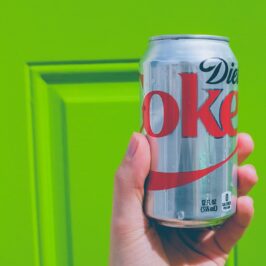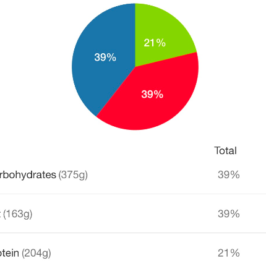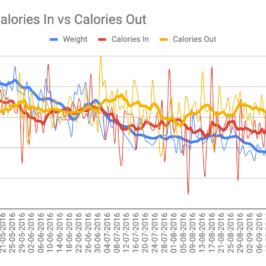- How Much Weight Can You Realistically Lose in 3 Months? - January 14, 2024
- How To Lose 1kg a Week (Guaranteed) - August 20, 2023
- How To Count Calories (or Estimate) and Stay on Track When Eating Out at Restaurants - July 25, 2023
TL,DR; No
The ‘calories burned’ number in FitBit, Apple Watch and My Fitness Pal is often very inaccurate, and more often than not overestimated, meaning that if you eat the calories ‘back’, you could be undermining your original goal; if that goal is weight loss.
Activity trackers will use all the information they have about you to give you your ‘calories burned’ number including your weight, age and heart rate – this might be a good rough indication – but it won’t be precise.
In fact, outside of a lab it’s going to be very difficult to get an exact number for calories burned.
When most people first start using My Fitness Pal they fixate on this number on the right
And think, great, I’ve got 1,700 calories left to eat today.
Time to fire up the Dominos app.
Big mistake.
This number could be incredibly misleading for a few reasons, and for that reason, as well as the ones below, you should pretty much completely disregard this figure.
If you still need convincing, here are the other reasons.
1. GOAL CALORIES MAY BE TOO HIGH
This is probably the most obvious reason to ignore the ‘remaining’ calories in My Fitness Pal.
If My Fitness Pal estimates that you’ve done 500 calories worth of exercise, and you’ve eaten the exact number of calories based on your goal (let’s say 2000 calories), your ‘remaining’ calories will be 500.
The reality might be that you actually only expended 250 calories, if you then eat 500 calories to compensate, you’ll theoretically be in a 250 calorie SURPLUS.
Not a huge issue if it’s a one-off, but let’s say you did exactly this for 14 days – that would mean a 3,500 calories surplus, which would roughly equal a pound of weight GAIN.
WANT TO WORK OUT YOUR CALORIE DEFICIT? DROP YOUR EMAIL BELOW AND I’LL SEND YOU THE GUIDE (2 EASY STEPS)
2. YOUR DAILY CALORIE TARGET MAY ALREADY INCLUDE ‘CALORIES BURNED’
This one is even more dangerous and has a much higher potential to sabotage your results.
When you set up your My Fitness Pal account, you’re asked to set a target end weight. My Fitness Pal will calculate your ‘goal’ calories based upon this and your activity level
So let’s say you tell My Fitness Pal that you’re ‘Lightly Active’ – it will build this into your calorie goals, and assume that you’re already burning a certain number of calories per day.
If you then add in the ‘Exercise’ calories, these could already be accounted for in your ‘goal’, meaning that you could be in a calorie surplus if ‘eat back’ your exercise calories.
Just to give you an idea of how much your ‘goal’ calories are affected by your activity level;
If I set my ‘activity level’ to ‘Not Very Active’, My Fitness Pal gives me a goal of 1,500 calories.
If I set it to ‘very Active’ I get a goal or 2,340 calories.
This is a HUGE difference (840 calories), so getting this wrong then following it religiously could really compromise you.
ESPECIALLY if you set it to ‘Very Active’ if you’re not, AND eat back your ‘exercise calories’.
3. YOU’LL BE CHASING YOUR TAIL
Even if if everything is 100% correct – checking how many calories you ‘can’ eat every day is not a fun way to live, trust me.
It means that your life will be dedicated by My Fitness Pal and you’ll be waiting right until the end of the day to check how many calories you’re ‘allowed’ to eat.
This could mean getting into a situation where you do a half marathon just so you can go order a takeaway.
You’re FAR better off just taking an educated guess at your required average daily calorie intake (or get a weight loss coach to help you) based on your AVERAGE amount of daily activity then aiming for that everyday.
Your life will be much easier if you know you’re aiming for around 2000 calories everyday, rather than waiting until 10pm to check if you can eat a box of Krispy Kremes, or that you’ve eaten too much and you need do a triathlon.
For this reason, when you’re dieting and counting calories, it’s sensible to try and do roughly the same amount of activity each week – whether that’s 6 Olympic Weight Lifting Sessions, 3 games or Five-a-Side and a 19 mile hike or a few walks around the block, it doesn’t matter, just keep it consistent.
Of course you might have the odd day here and there where you do a lot more exercise than normal, but don’t see this as an opportunity to ‘replace’ the calories – just see it as getting toward your weight loss goal that little bit quicker.
4. YOU’RE NOT TRAINING HARD ENOUGH
Whatever your goal is, the actual need to ‘eat back’ or replace calories probably doesn’t exist.
There are of course some edge cases but these are pretty much reserved or professional athletes.
Tour de France riders for example would need to replace the calories they burn each day to fuel them for the next day, but that’s literally because they require the fuel to perform optimally.
If you’ve done a Peleton class and burned 300 calories, there is NO need to replace those calories, especially if you’re trying to lose weight.
If weight loss is the goal – treat each season as something that nudges your a little close to your goal – not some athletic endeavour that needs to be compensated for.
5. NOT EATING IS IS EASIER THAN EXERCISING
Just exercising to lose weight is a really bad idea.
That might sound ridiculous, but it’s true.
Think about it.
How long does it take the average person to burn 300 calories? Probably about half an hour.
How do you feel after than run or spin class?
Hungry.
The likelihood is you’ll probably end up eating more than 300 calories because you’ve stimulated your appetite.
On the other hand, how long does it take to NOT EAT 300 calories?
No time at all.
That’s exactly why diet is so much more powerful for controlling your weight than exercise.
Now, am I saying don’t bother exercising; obviously not.
Exercise has a ton of other benefits other than just burning calories, so carry on doing whatever you love, but from a weight loss point of view, just assume that your activity burns no calories and you can’t go far wrong.
SUMMARY
If you’re trying to lose weight, you’ll need to set a calorie goal. This calorie goal will (or should) be based on your Basal Metabolic rate (which is determined by your gender, age, and weight) and the average amount of daily exercise you do. Including the (estimated) calories burned by exercise and/or general movement into your goal will mean this is already accounted for, so you ignore the ‘remaining’ calories.









Leave a Reply